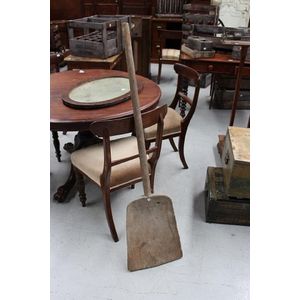Victorian Walnut Banquet Table & Chairs
A late 19th century walnut banquet table, maker W Walker & Sons 119 Bunhill Row London. Rectangular form with canted corners, four leaves on bulbous legs terminating in terracotta castors. Together with a matching set of set dining chairs. 360 cm long, 135 cm wide.
You must be a subscriber, and be logged in to view price and dealer details.
Subscribe Now to view actual auction price for this item
When you subscribe, you have the option of setting the currency in which to display prices to $Au, $US, $NZ or Stg.
This item has been sold, and the description, image and price are for reference purposes only.
- Terracotta - Terracotta is lightly fired earthenware, red or reddish-brown in colour, used in ancient times. Fired at higher temperatures terracotta was used in the nineteenth century for decorative vases and similar objects, but rarely for utilitarian goods. Other uses for terracotta include roofing tiles, garden pots and ornaments. Glazed terracotta is known as faience.
- Canted Corners - In decorative arts, especially furniture making, a canted corner refers to a technique where the corner of the piece is angled or "canted" to create a diagonal corner. This is different from a chamfered corner which is a technique where the edges of a corner are cut at an angle, creating a diagonal edge or "bevel" along the corner.
A canted corner is typically used to add visual interest to the item. It can be found in various styles of furniture such as contemporary, Art Deco, or traditional. It is often used to create a sense of movement and dynamism in a piece.
Canting a corner is a more complex technique than chamfering, and it is typically done by tilting the corner of a piece of furniture and then cutting the wood to match the angle. It's a technique that requires precise measurements and a good understanding of angles and geometry, and it is usually done by experienced artisans. - Castors - Wheels, fitted especially to chair legs, couches, tables and some smaller pieces of furniture, to enable them to be easily moved about. The earliest castors were of brass, with shanks fitting into the base of the leg, and the wheels often made of leather. In the late 18th century, brass 'bucket' or 'cup' castors were introduced, either rounded or square, fitting directly over the end of the leg and held in place with screws. The wheels were generally solid brass. Bucket/cup castors continued in use throughout the 19th century and indeed are still made today. In the later 19th century wheels were sometimes made of wood, china, either white or brown, and sometimes of steel.
This item has been included into following indexes:
- tables, large dining
Visually similar items

Antique 19th century French Oven paddle, approx 133 cm long, 35 cm wide
Sold by
in
for
You can display prices in $Au, $US, $NZ or Stg.

A 19th/20th century mahogany wine table
Sold by
in
for
You can display prices in $Au, $US, $NZ or Stg.

Set of six antique French Henri II walnut embossed leather upholstered chairs (6)
Sold by
in
for
You can display prices in $Au, $US, $NZ or Stg.

Six Chinese blackwood Qing chairs with marble insert backs, 2 chairs matching and 4 other chairs
Sold by
in
for
You can display prices in $Au, $US, $NZ or Stg.
